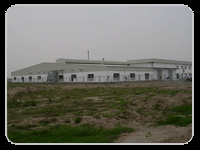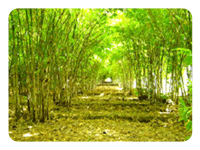
Bamboo is a group of tall arborescent grasses, play an important role in the economy of the world. In the areas of their preponderance, bamboo is intimately linked with the socio- economic development of the rural communities. The importance of Bamboo as an Eco-friendly raw material capable of meeting multifarious needs of the people at large is gaining global acceptance. From a raw material known as the poor man's timber bamboo is currently being elevated to the status of the timber of the 21st century and from poor man timer to common man timber.
So varied is bamboos application that one finds its utilization on a massive scale today in environment protection, as a nutrient food, high-value construction material and also in about 1,500 other listed applications. Experts working in the field of bamboo are of the opinion that the full potential of this raw material still remains to be understood or tapped.
From its all-pervading dominance in the agrarian economies of the East during the middle ages and the subsequent oblivion in the 19th and 20th centuries, bamboo is once again emerging as a much sought after material in the hi-tech world of the 21st century.
It is estimated that about 2.5 billion people use bamboo in one form or the other at the global level. The annual turnover is estimated around US $ 10 billion (Rs.50,000 crores) and this is estimated to shoot up to USD 20 billion by in 2015. Advanced research activities are conducted to utilize bamboo for efficient fuel generating system.
Networks like the International Network for Bamboo and rattan (INBAR) are functioning at the international level. The Govt. of India is a signatory to this network. At the global level, primary processing and product manufacturing is shifting to a highly mechanized mode.
BAMBOO IN INDIA

India, having about 136 species, has the worlds richest resources of bamboos. Bamboo has been associated with people since ancient times. Being a natural gift to the mankind, bamboo is very popular due to its multi purpose use, fast growth, easy propagation, soil binding properties and short gestation period as compared to trees. Every part of bamboo is utilized in one-way or the other. It has a high calorific value of 4600 to 5400 cal/kg., which makes it an energy crop. Rural and urban people use it for a variety of purposes. Bamboo provides basic necessities of life i.e. fuel, food, shelter and clothing, particularly to the rural people and is also a source of raw material for cottage, small and medium scale industries. Keeping in view its versatile uses, the potential of bamboo can be harnessed for the service of the poor and for eradication of poverty. Cultivation of bamboo can reduce pressure of fuel, fodder and small timber from forest areas.
In India 136 species of bamboos in 36 genera are found to exist. The North East India holds the largest stock and diversity of bamboos. Next to the N.E., the Western ghats area has the second largest diversity of bamboos.
Though India has the largest area under bamboo which is estimated around 9.6 million hectares, the yield per ha is estimated around 0.4 tonnes, which is very low in comparison to other countries like China, Malaysia, Costa Rica etc.
It is estimated that 8 million bamboo artisans are depended on this craft for their livelihood. The annual turnover of the bamboo sector in India is estimated to be around Rs. 2400 crores. By and large, this is a totally unorganized sector and bamboo has always been considered from the craft point of view and if otherwise for pulp making only.
This craft has been practiced by the North Eastern States for centuries as their prime income source and, in the process, the weaving skills of the artisans had evolved to levels comparable with the craftsperson from more affluent societies like Japan, China etc. though the product diversity still remains undeveloped.